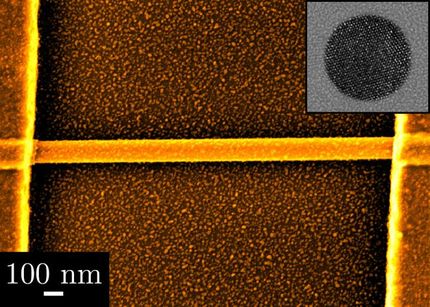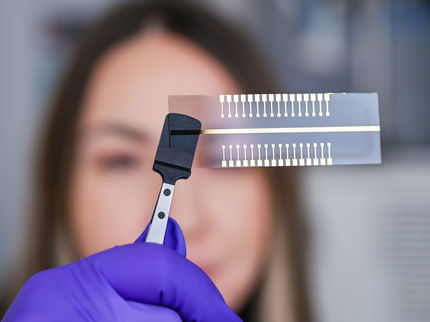New type of biosensor is fast, super-sensitive
Detects one-billionth of a gram in minutes
A whole new class of biosensor that can detect exceptionally small traces of contaminants in liquids in just 40 minutes has been developed by a UNSW-led team of researchers.
Known as a biochemiresistor, it meets a long-standing challenge to create a sensor that is not only super-sensitive to the presence of chemical compounds but responds quickly. It has countless potential uses for detecting drugs, toxins and pesticides for biomedical or environmental analysis.
In a paper published in the prestigious chemistry journal Angewandte Chemie the researchers describe how they successfully tested the new sensor by detecting tiny traces in milk of the veterinary antibiotic enrofloxacin. The journal has singled out the study for attention as a "Very Important Paper". Only 5% of papers published by the journal are so designated.
"Enrofloxacin is an antibiotic used in the agricultural industry that can be transferred to the food chain," notes co-author Scientia Professor Justin Gooding, of the UNSW School of Chemistry and the Australian Centre for Nanomedicine.
"Our biochemiresistor was able to detect enrofloxacin in neat milk in 40 minutes, at level as low as one nanogram in a litre of milk. To put that number in perspective, a nanogram is a billionth of a gram and is the mass of a single cell.
"While that is impressive enough, the sensor is a general concept that can be widely applied across many different fields."
A biosensor is a portable analytical device that uses biological molecules to detect selectively just one compound within a mix of many others. Small biosensors are already in daily use testing the safety of drinking water, for checking diabetic blood-sugar levels and for pregnancy tests
The biochemiresistor uses gold-coated magnetic nanoparticles modified with antibodies that are selective for the chemical constituent – or analyte - of interest. The nanoparticles are dispersed into the sample for analysis and if the analyte is present some of the antibodies detach from the nanoparticles.
Using a magnet, the nanoparticles are then assembled into a film between two electrodes and the electrical resistance is measured. The more analyte is present, the more antibodies leave the nanoparticles and the lower the resistance in the nanoparticle film.
"This new type of biosensor is rapid in response because the magnetic nanoparticle biosensors go and get the analyte rather than the usual approach of waiting for the analyte to find the sensing surface," says Gooding.
"The biochemiresistor is also more sensitive than the usual biosensor because, as the nanoparticles are dispersed throughout the sample, the entire sample is analysed, not just a small portion of the solution."
Organizations
Other news from the department science
These products might interest you

Octet R2 / Octet R4 / Octet R8 by Sartorius
Full power on 2, 4 or 8 channels: Label-free and GxP-compliant analysis of molecular interactions
Innovative label-free real-time protein quantification, binding kinetics and rapid screenings

Octet RH16 and RH96 by Sartorius
Efficient protein analysis for process optimisation and manufacturing control in high-throughput
Label-free protein quantification and characterization of protein-protein interactions

Octet SF3 by Sartorius
Surface Plasmon Resonance (SPR) using Single Dynamic Injections for Kinetics and Affinities
Curvature is Key - Adding a ‘Third Dimension’ to the Binding Curve

Get the analytics and lab tech industry in your inbox
By submitting this form you agree that LUMITOS AG will send you the newsletter(s) selected above by email. Your data will not be passed on to third parties. Your data will be stored and processed in accordance with our data protection regulations. LUMITOS may contact you by email for the purpose of advertising or market and opinion surveys. You can revoke your consent at any time without giving reasons to LUMITOS AG, Ernst-Augustin-Str. 2, 12489 Berlin, Germany or by e-mail at revoke@lumitos.com with effect for the future. In addition, each email contains a link to unsubscribe from the corresponding newsletter.
























































